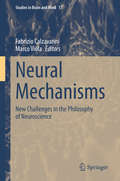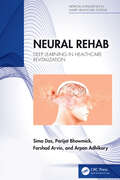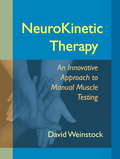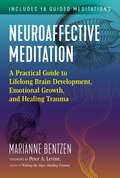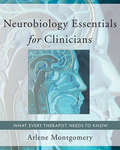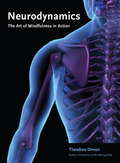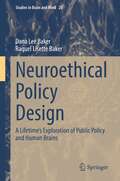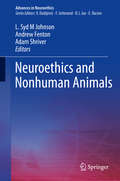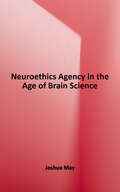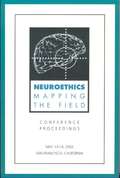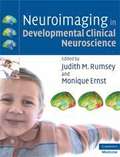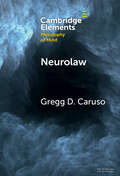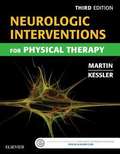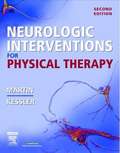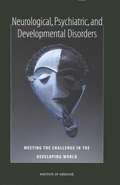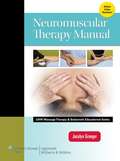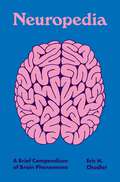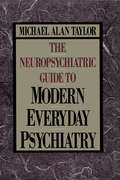- Table View
- List View
Neural Machines: A Defense of Non-Representationalism in Cognitive Neuroscience (Studies in Brain and Mind #22)
by Matej KohárIn this book, Matej Kohar demonstrates how the new mechanistic account of explanation can be used to support a non-representationalist view of explanations in cognitive neuroscience, and therefore can bring new conceptual tools to the non-representationalist arsenal. Kohar focuses on the explanatory relevance of representational content in constitutive mechanistic explanations typical in cognitive neuroscience. The work significantly contributes to two areas of literature: 1) the debate between representationalism and non-representationalism, and 2) the literature on mechanistic explanation.Kohar begins with an introduction to the mechanistic theory of explanation, focusing on the analysis of mechanistic constitution as the basis of explanatory relevance in constitutive mechanistic explanation. He argues that any viable analysis of representational contents implies that content is not constitutively relevant to cognitive phenomena. The author also addresses objections against his argument and concludes with an examination of the consequences of his account for both traditional cognitive neuroscience and non-representationalist alternatives. This book is of interest to readers in philosophy of mind, cognitive science and neuroscience.
Neural Mechanisms: New Challenges in the Philosophy of Neuroscience (Studies in Brain and Mind #17)
by Fabrizio Calzavarini Marco ViolaThis volume brings together new papers advancing contemporary debates in foundational, conceptual, and methodological issues in cognitive neuroscience. The different perspectives presented in each chapter have previously been discussed between the authors, as the volume builds on the experience of Neural Mechanisms (NM) Online – webinar series on the philosophy of neuroscience organized by the editors of this volume. The contributed chapters pertain to five core areas in current philosophy of neuroscience. It surveys the novel forms of explanation (and prediction) developed in cognitive neuroscience, and looks at new concepts, methods and techniques used in the field. The book also highlights the metaphysical challenges raised by recent neuroscience and demonstrates the relation between neuroscience and mechanistic philosophy. Finally, the book dives into the issue of neural computations and representations. Assembling contributions from leading philosophers of neuroscience, this work draws upon the expertise of both established scholars and promising early career researchers.
Neural Rehab: Deep Learning in Healthcare Revitalization (Artificial Intelligence in Smart Healthcare Systems)
by Arpan Adhikary Sima Das Parijat Bhowmick Farshad ArvinIn recent years, the integration of cutting-edge technology with healthcare has led to groundbreaking advancements. Deep learning, in particular, has emerged as a revolutionary force, poised to transform the field of neural rehabilitation. This book sets the stage for the exploration of deep learning's significant impact on the revitalization of healthcare through neural rehabilitation.Neural Rehab: Deep Learning in Healthcare Revitalization offers a detailed exploration of the intersection between deep learning and neural rehabilitation, shedding light on a critical area in healthcare. Through real-life examples and case studies, readers will gain a practical understanding of how deep learning is utilized in everyday healthcare settings to improve patient outcomes. The focus is on how deep learning algorithms are being used to personalize rehabilitation plans, demonstrating how technology can tailor interventions to meet the unique needs and progress of each individual. The book covers various aspects of neural rehabilitation, such as stroke recovery, brain injuries, and neurological disorders, providing readers with a comprehensive understanding of the subject matter. A key emphasis is placed on the patient-centric approach, showcasing how deep learning contributes to enhanced patient experiences, improved recovery, and an overall better quality of life.This book is essential reading for healthcare professionals, researchers, and anyone interested in the intersection of deep learning and neural rehabilitation.
NeuroKinetic Therapy
by David WeinstockNeuroKinetic Therapy is based on the premise that when an injury has occurred, certain muscles shut down or become inhibited, forcing other muscles to become overworked. This compensation pattern can create pain or tightness. By applying light pressure that the client then resists, the practitioner can evaluate the strength or weakness of each muscle, revealing the sources of injury and retraining the client's body to remove the compensation patterns--reprogramming the body at the neural level.This easy-to-follow practitioner's manual presents a series of muscle tests specially designed to uncover and resolve compensation patterns in the body. Author David Weinstock begins by explaining how this approach stimulates the body and mind to resolve pain. Organized anatomically, each section of the book includes clear photographs demonstrating correct positioning of the muscle accompanied by concise explanations and instructions. Labeled anatomical illustrations appear at the end of each section showing the relationships between the muscles and muscle groups. This essential resource is especially useful for physical therapists, chiropractors, orthopedists, and massage therapists looking for new ways to treat underlying causes of pain.
Neuroaffective Meditation: A Practical Guide to Lifelong Brain Development, Emotional Growth, and Healing Trauma
by Marianne Bentzen• Shares 16 guided meditations for neuroaffective brain development and emotional maturation, along with links to online recordings • Explores the stages of emotional development, from childhood to old age, and their potentials for developing new ways of functioning • Reveals the biopsychological effects of meditation on the human brain, including how it affects us at the autonomic, limbic, and prefrontal levels Drawing on her 25 years of research into brain development as well as decades of meditation practice, psychotherapist Marianne Bentzen shows how neuroaffective meditation--the holistic integration of meditation, neuroscience, and psychology--can be used for personal growth and conscious maturation. She also explores how the practice can help address embedded traumas and allow access to the best perspectives of growing older while keeping the best psychological attitudes of being young--a hallmark of wisdom. She explains that there is a sequence to emotional maturation, just as there is for the development of cognitive or athletic skills, and details the central developmental processes of childhood and adolescence and the adult stages of psychological development. She then explores the biopsychological effects of meditation on the human brain, including how it affects us at the autonomic, limbic, and prefrontal levels. The author shares 16 guided meditations for neuroaffective brain development (along with links to online recordings), each designed to gently interact with the deep, unconscious layers of the brain and help you reconnect to yourself, your relationships, and the world around. Each meditation explores a different theme, from breathing in &“being in your body&” to feeling love, compassion, and gratitude in &“the songs of the heart&” to balancing positive and negative experiences in &“mandala.&” The author also shares a 5-part meditation centered on breathing exercises designed to balance your energy. Presenting an authentic, stepwise approach to spiritual growth, emotional maturation, and brain development, this guide explains the science behind neuroaffective meditation and offers detailed practices for a truly personal and ever-evolving experience of inner wisdom and growth.
Neurobehavioral Anatomy, Third Edition
by Christopher M. FilleyThoroughly revised and updated to reflect key advances in behavioral neurology, Neurobehavioral Anatomy, Third Edition is a clinically based account of the neuroanatomy of human behavior centered on a consideration of behavioral dysfunction caused by disorders of the brain. A concise introduction to brain-behavior relationships that enhances patient care and assists medical students, the book also serves as a handy reference to researchers, neuroscientists, psychiatrists, and geriatricians. The book outlines how cognitive and emotional functions are represented and organized in the brain to produce the behaviors regarded as uniquely human. It reviews the effects of focal and diffuse brain lesions, and from this analysis a conception of the normal operations of the healthy brain emerges. Christopher M. Filley integrates data and material from different disciplines to create a concise and accessible synthesis that informs the clinical understanding of brain-behavior relationships. Clinically practical and theoretically stimulating, the book is an invaluable resource for those involved in the clinical care and study of people with neurobehavioral disorders. Including a useful glossary and extensive references guiding users to further research, the third edition will be of significance to medical students, residents, fellows, practicing physicians, and the general reader interested in neurology.
Neurobiology Essentials for Clinicians: What Every Therapist Needs to Know
by Arlene Montgomery Allan N. SchoreThis book presents an overview of the latest theories of affect regulation and focuses on how these theories work in clinical settings and how therapists can be taught to implement them. The notion of teaching and learning will be extended by the theories themselves-the author presents methods of education that enact the theories being taught. The book is divided into eight chapters, each one highlighting a particular structure or related structures of the brain. Suggestions for learning how to clinically apply the neurobiological/neuroanatomical information are offered. What is so unique about this book is that the bulk of the chapters are clinical dialogue, accompanied by neurobiological commentary. Thus, readers can see for themselves, during the course of parts of sessions, just how a "neurobiological outlook" can inform therapeutic understandings of what clients are doing and saying. The result is a very user-friendly learning experience for readers, as they are taken along a journey of understanding various brain systems and how they relate to psychotherapeutic principles. Elegantly bridging the gap between the academic and clinical domains, this book is essential for anyone interested in the application of neurobiological principles to psychotherapy and wishes to learn about neurobiology without feeling overwhelmed or intimidated.
Neurodharma: New Science, Ancient Wisdom, and Seven Practices of the Highest Happiness
by Rick Hanson PhDLOS ANGELES TIMES BESTSELLER • &“An easy-to-follow road map for creating day-to-day inner peace in today&’s increasingly complex world.&”—Lori Gottlieb, MFT, New York Times bestselling author of Maybe You Should Talk to SomeoneThroughout history, people have sought the heights of human potential—to become as wise and strong, happy and loving, as any person can ever be. And now recent science is revealing how these remarkable ways of being are based on equally remarkable changes in our own nervous system, making them more attainable than ever before. In Neurodharma, the follow-up to his classic Buddha&’s Brain, New York Times bestselling author Rick Hanson, PhD, not only explores the new neuroscience of awakening but also offers a bold yet plausible plan for reverse-engineering peak experiences, sense of oneness, and even enlightenment itself. And he does so with his trademark blend of solid science and warm encouragement, guiding you along this high-reaching path with good humor, accessible tools, and personal examples. A groundbreaking yet practical book, Neurodharma shares seven practices for strengthening the neural circuitry of profound contentment and inner peace—qualities that offer essential support in everyday life while also supporting the exploration of the most radical reaches of human consciousness. Step by step, this book explains how to apply these insights in order to cultivate unshakable presence of mind, a courageous heart, and serenity in a changing world. The breakthroughs of the great teachers are not reserved for the chosen few. Dr. Hanson shows how we can embody them ourselves in daily life to handle stress, heal old pain, feel at ease with others, and rest in the sense of our natural goodness. The Buddha didn&’t use an MRI to become enlightened. Still, 2,500 years after he walked the dusty roads of northern India, neuroscientists are discovering the mechanisms of the brain that underpin the Buddha&’s penetrating analysis of the mind. With deep research, stories, guided meditations, examples, and applications, Dr. Hanson offers a fascinating, inspiring vision of who we can be—and an effective path for fulfilling this wonderful possibility.
Neurodynamics
by Theodore Dimon G. David BrownNeurodynamics combines the latest discoveries in science, anatomy, and mindfulness to form a new understanding of human awareness in action. What good does it do to stretch, relax, or strengthen muscles if we don't know how these muscles are actually designed to function? To be sound, any physical therapy method must be based on scientific knowledge of how the musculoskeletal system works, on the role of proprioception in gaining awareness and control over this system, and on the process of becoming more conscious in action. Written for both beginning and advanced students, the book offers in-depth explanations of the theory of neurodynamics together with illustrations outlining steps of development and practical exercises. Over 100 years ago, F. Matthias Alexander made a series of discoveries about how the body works in action that made it possible for the first time to become conscious of what we're doing in activity. In Neurodynamics, author Theodore Dimon, who has taught and written about Alexander's work for many years, seeks to put together a coherent theory and curriculum for the Alexander Technique and explain how this system works in scientific terms. Neurodynamics develops and expands on Alexander's teachings and gives practical explanations that form the basis not just for a method but for a truly educational theory of how the mind and body work in action.
Neuroethical Policy Design: A Lifetime’s Exploration of Public Policy and Human Brains (Studies in Brain and Mind #20)
by Dana Lee Baker Raquel Lisette BakerThis volume focuses on the emergent field of neuroethics comparing and contrasting how two democracies, Canada and the United States, have begun adapting public policy design to better fit human minds. The book focuses on issues relevant to all members of the general population and discusses a series of policy issues arranged roughly in the order in which they become relevant in a typical person’s lifetime. After the introductory chapter each chapter considers an area of public policy particularly relevant to a different stage of life—from early childhood education policy, to policies for higher education and the workplace, to end of life decisions in living wills and advance directives. The author puts forth that making the shift towards more neurologically appropriate policy will likely be a gradual process hampered primarily by two issues. The first is the inability of neuroscientists to come to agreement on increasingly sophisticated research findings. The second issue points out that bringing policy and neurology into a more synchronous relationship requires a commitment to prolonged effort involves the largely unrecognized reality of entrenched neurological interests. The first chapter introduces the concept of disconnect between policy design with traditional understandings of the brain and goes on to highlight developments in the science of human neurology in recent years. To help contextualize the book, examples of neurological misperceptions are explored in this introductory chapter. Chapters Two through Eleven each explores a specific type of policy, incorporating understandings of the human brain which, modern neuroscience suggests, are debatable.
Neuroethics and Nonhuman Animals (Advances in Neuroethics)
by Andrew Fenton L. Syd M Johnson Adam ShriverThis edited volume represents a unique addition to the available literature on animal ethics, animal studies, and neuroethics. Its goal is to expand discussions on animal ethics and neuroethics by weaving together different threads: philosophy of mind and animal minds, neuroscientific study of animal minds, and animal ethics. Neuroethical questions concerning animals’ moral status, animal minds and consciousness, animal pain, and the adequacy of animal models for neuropsychiatric disease have long been topics of debate in philosophy and ethics, and more recently also in neuroscientific research. The book presents a transdisciplinary blend of voices, underscoring different perspectives on the broad questions of how neuroscience can contribute to our understanding of nonhuman minds, and on debates over the moral status of nonhuman animals. All chapters were written by outstanding scholars in philosophy, neuroscience, animal behavior, biology, neuroethics, and bioethics, and cover a range of issues and species/taxa. Given its scope, the book will appeal to scientists and students interested in the debate on animal ethics, while also offering an important resource for future researchers. Chapter 13 is available open access under a CC BY 4.0 license at link.springer.com.
Neuroethics: Agency in the Age of Brain Science
by Joshua MayIs free will an illusion? Is addiction a brain disease? Should we enhance our brains beyond normal? Neuroethics blends philosophical analysis with modern brain science to address these and other critical questions through captivating cases. The result is a nuanced view of human agency as surprisingly diverse and flexible. With a lively and accessible writing style, Neuroethics is an indispensable resource for students and scholars in both the sciences and humanities.
Neuroethics: Mapping the Field
by Steven J. MarcusThis volume contains the proceedings of a two-day multidisciplinary conference on the ethical implications of brain research organized by Stanford University and the University of California, San Francisco. Leaders in neuroscience, journalism, law, and philosophy, among other fields, engaged in a freewheeling debate on the social and individual effects of the research. Steven Marcus has edited their formal and informal deliberations to present a compelling first-hand account of the proceedings, providing a highly readable front-row seat about the first-ever symposium on neuroethics.
Neuroimaging in Developmental Clinical Neuroscience
by Judith M. Rumsey Monique Ernst Husseini K. ManjiModern neuroimaging offers tremendous opportunities for gaining insights into normative development and a wide array of developmental neuropsychiatric disorders. Focusing on ontogeny, this text covers basic processes involved in both healthy and atypical maturation, and also addresses the range of neuroimaging techniques most widely used for studying children. This book will enable you to understand normative structural and functional brain maturation and the mechanisms underlying basic developmental processes; become familiar with current knowledge and hypotheses concerning the neural bases of developmental neuropsychiatric disorders; and learn about neuroimaging techniques, including their unique strengths and limitations. Coverage includes normal developmental processes, atypical processing in developmental neuropsychiatric disorders, ethical issues, neuroimaging techniques and their integration with psychopharmacologic and molecular genetic research approaches, and future directions. This comprehensive volume is an essential resource for neurologists, neuropsychologists, psychiatrists, pediatricians, and radiologists concerned with normal development and developmental neuropsychiatric disorders.
Neuroimaging of Sleep and Sleep Disorders
by Michael J. Thorpy Eric Nofzinger Pierre MaquetThis up-to-date, superbly illustrated book is a practical guide to the effective use of neuroimaging in the patient with sleep disorders. There are detailed reviews of new neuroimaging techniques - including CT, MRI, advanced MR techniques, SPECT and PET - as well as image analysis methods, their roles and pitfalls. Neuroimaging of normal sleep and wake states is covered plus the role of neuroimaging in conjunction with tests of memory and how sleep influences memory consolidation. Each chapter carefully presents and analyzes the key findings in patients with sleep disorders indicating the clinical and imaging features of the various sleep disorders from clinical presentation to neuroimaging, aiding in establishing an accurate diagnosis. Written by neuroimaging experts from around the world, Neuroimaging of Sleep and Sleep Disorders is an invaluable resource for both researchers and clinicians including sleep specialists, neurologists, radiologists, psychiatrists, psychologists.
Neurolaw (Elements in Philosophy of Mind)
by Gregg D. CarusoNeurolaw is an area of interdisciplinary research on the meaning and implications of neuroscience for the law and legal practices. This Element addresses the potential contributions of neuroscience, and the brain sciences more generally, to criminal justice decision-making and policy. It distinguishes between three different areas and domains of investigation in neurolaw: assessment, intervention, and revision. The first concerns brain-based assessments, which may be used for predicting future violence, lie detection, judging legal insanity, and the like. The second concerns potential treatments and other interventions that aim at rehabilitating criminals and/or preventing crime before it occurs. The third investigates the ways that neuroscience may impact the law by changing or revising commonsense views about human nature and the causes of human action.
Neurologic Interventions for Physical Therapy
by Mary Kessler Suzanne Tink" MartinMaster the role of the physical therapist or physical therapist assistant in neurologic rehabilitation! Neurologic Interventions for Physical Therapy, 3rd Edition helps you develop skills in the treatment interventions needed to improve the function of patients with neurologic deficits. It provides a solid foundation in neuroanatomy, motor control, and motor development, and offers clear, how-to guidelines to rehabilitation procedures. Case studies help you follow best practices for the treatment of children and adults with neuromuscular impairments caused by events such as spinal cord injuries, cerebral palsy, and traumatic brain injuries. Written by physical therapy experts Suzanne 'Tink' Martin and Mary Kessler, this market-leading text will help you prepare for the neurological portion of the PTA certification exam and begin a successful career in physical therapy practice. Comprehensive coverage of neurologic rehabilitation explores concepts in neuroanatomy, motor control and motor learning, motor development, and evidence-based treatment of adults and children with neuromuscular impairments.
Neurologic Interventions for Physical Therapy (Second Edition)
by Mary Kessler Suzanne Tink MartinNow completely updated with the latest information on both adult and pediatric patients, this comprehensive book provides a link between the pathophysiology of neurologic deficits and possible rehabilitation interventions for improving movement outcomes. It introduces the structure and function of the nervous system and describes normal motor development, motor control and motor learning, pathophysiology of the nervous system and common treatment techniques used in physical therapy practice. This edition also features updated terminology from the APTA's Guide to Physical Therapist Practice, as well as new chapters on proprioceptive neuromuscular facilitation (PNF) and other neurological conditions seen in the adult. Helpful learning aids and abundant illustrations highlight key concepts and help readers quickly master the material. Helpful learning aids - such as objectives, tables, illustrated intervention boxes, and review questions - reinforce important facts and concepts. Review questions at the end of each chapter allow readers to test their understanding of the material. 700 illustrations clearly depict procedures discussed in the text and clarify descriptions of anatomy, physiology, evaluation, pathology, and treatment. Background information is provided for interventions that can be used in the rehabilitation of adults and children, promoting a complete understanding of techniques. Careful documentation uses current outcomes-based research. Case histories include subjective and objective observation, assessment, planning, and critical decision-making components. Current language of the APTA's Guide to Physical Therapist Practice, 2nd Edition is used throughout, aligning all information with best practices put forth by the APTA. A new chapter on proprioceptive neuromuscular facilitation (PNF) describes how these techniques can be used to improve performance of functional tasks by increasing strength, flexibility, and range of motion.
Neurological, Psychiatric, and Developmental Disorders: Meeting the Challenge in the Developing World
by Institute of MedicineBrain disorders—neurological, psychiatric, and developmental—now affect at least 250 million people in the developing world, and this number is expected to rise as life expectancy increases. Yet public and private health systems in developing countries have paid relatively little attention to brain disorders. The negative attitudes, prejudice, and stigma that often surround many of these disorders have contributed to this neglect. Lacking proper diagnosis and treatment, millions of individual lives are lost to disability and death. Such conditions exact both personal and economic costs on families, communities, and nations. The report describes the causes and risk factors associated with brain disorders. It focuses on six representative brain disorders that are prevalent in developing countries: developmental disabilities, epilepsy, schizophrenia, bipolar disorder, depression, and stroke. The report makes detailed recommendations of ways to reduce the toll exacted by these six disorders. In broader strokes, the report also proposes six major strategies toward reducing the overall burden of brain disorders in the developing world.
Neuromuscular Disease: A Case-Based Approach
by John H. J. Wokke Pieter A. van Doorn Jessica E. Hoogendijk Marianne de Visser John H. J. Wokke Pieter A. van Doorn Jessica E. Hoogendijk Marianne De VisserThere are over 600 neuromuscular disorders and the variability of these syndromes can leave clinicians feeling as if they are lost in a maze as they seek to diagnose and manage patients. This book addresses this problem by using the case-history and symptom manifestation as a starting point for the diagnostic process in adult patients, mimicking the situation in the consultation room. For each case, diagnostic tools, disease pathogenesis, prognosis and treatment options are discussed, along with rare manifestations and differential diagnoses. Symptoms, signs and syndromes are cross-linked to help the reader navigate the variety of disorders. Accompanying tables give a broader picture of the manifestations of a particular disease within the landscape of neuromuscular disorders. This highly-illustrated book, with accompanying videos, will aid neurologists at all levels, internists, geneticists, rehabilitation physicians and researchers in the field, as they seek to familiarize themselves with this complex range of disorders.
Neuromuscular Therapy Manual
by Jocelyn Granger"Neuromuscular Therapy Manual is a concise "essentials" manual of neuromuscular massages therapy and trigger point therapy. The book is designed specifically for the needs of massage therapy students. Content is presented in a highly easy-to-use format provided by publisher.
Neuropedia: A Brief Compendium of Brain Phenomena (Pedia Books #12)
by Eric H. ChudlerA fun and fact-filled A–Z treasury for anyone with a head on their shouldersNeuropedia journeys into the mysteries and marvels of the three pounds of tissue between your ears—the brain. Eric Chudler takes you on a breathtaking tour of the nervous system with dozens of entries that explore the structure and function of the brain and cover topics such as the spinal cord and nerve cells, the methods of neuroscientific research, and the visionary scientists who have dedicated their lives to understanding what makes each of us who we are.The brain has fascinated and puzzled researchers, physicians, and philosophers for thousands of years and captivated us with each new discovery. This compendium of neuroscientific wonders is brimming with facts and insights, helping us to make sense of our current understanding of the nervous system while identifying the frontiers in our knowledge that remain unexplored. Chudler guides readers through a variety of rare and common neurological disorders such as alien hand disorder, Capgras syndrome, Alzheimer’s disease, Parkinson’s disease, and stroke, and discusses the latest brain-imaging methods used to diagnose them. He discusses neurochemicals, neurotoxins, and lifesaving drugs, and offers bold perspectives on human consciousness that enable us to better appreciate our place in nature.With marvelous illustrations by Kelly Chudler, Neuropedia is an informative and entertaining trip into the inner world of the brain.
Neuropsychiatric Guide to Modern Everyday Psychiatry
by Michael Alan TaylorPresents a new view of psychiatry, blending traditional biologic, neuro- and descriptive psychiatry into a broad neuropsychiatric approach to diagnosis and treatment. Incorporating step-by-step assessment and management strategies, Taylor provides a practical guide for clinical care.
Neuropsychological Consequences of COVID-19: Life After Stroke and Balint's Syndrome (ISSN)
by Barbara Wilson Jonathan Evans Narinder Kapur Jwala Narayanan Anjana XavierNeuropsychological Consequences of COVID-19 focuses on Anjana’s journey as a COVID survivor following a brain injury that left her with a very rare neuropsychological syndrome called Balint’s syndrome, a disorder associated with difficulties in visual and spatial coordination. It is also the first book of its kind to provide a first-hand account from India on surviving brain injury, from diagnosis, recovery and rehabilitation, providing the therapeutic milieu in the Indian context and exploring cultural influences on rehabilitation.Written jointly by Anjana, her neuropsychologist and the international experts in the field of neuropsychology who were also involved in her diagnosis and care, the book highlights how COVID-19, a virus primarily affecting the respiratory system, can also result in a disabling brain injury. It describes Anjana’s recovery and the rehabilitation she received and provides a deeper understanding of this experience of a very rare condition through the views of Anjana herself. In addition, Anjana’s rehabilitation journey stumbles upon many important themes of rehabilitation including cultural sensitivity, personal identity, resilience, role of family and rehabilitation in a low to middle income country.This book is valuable reading for clinical and neuropsychologists, neurologists, other rehabilitation therapists including physiotherapists, occupational therapists, nurses and social work professionals, particularly those interested in cross cultural rehabilitation. It will also be of interest to students in these fields.
Neuropsychological Neurology
by A. J. LarnerEssential to the management of patients suffering from neurological disorders is an understanding of the cognitive aspects of these conditions. This book begins with an outline of the various cognitive domains and how they can be tested, before covering in depth the cognitive deficits seen not only in prototypical neurodegenerative cognitive disorders (Alzheimer's disease, frontotemporal dementias, Huntington's disease, prionoses), but also in other common neurological disorders which may be complicated by cognitive impairment (stroke, multiple sclerosis, Parkinson's disease, brain tumours). This book is an essential reference text for all neurologists, not just those with an interest in cognitive disorders; and for general physicians and specialists who deal with any endocrine, metabolic, vascular, or infective disorders which may compromise cognitive function. Practitioners of professions allied to medicine which involve contact with cognitively impaired patients will also find this text useful.

